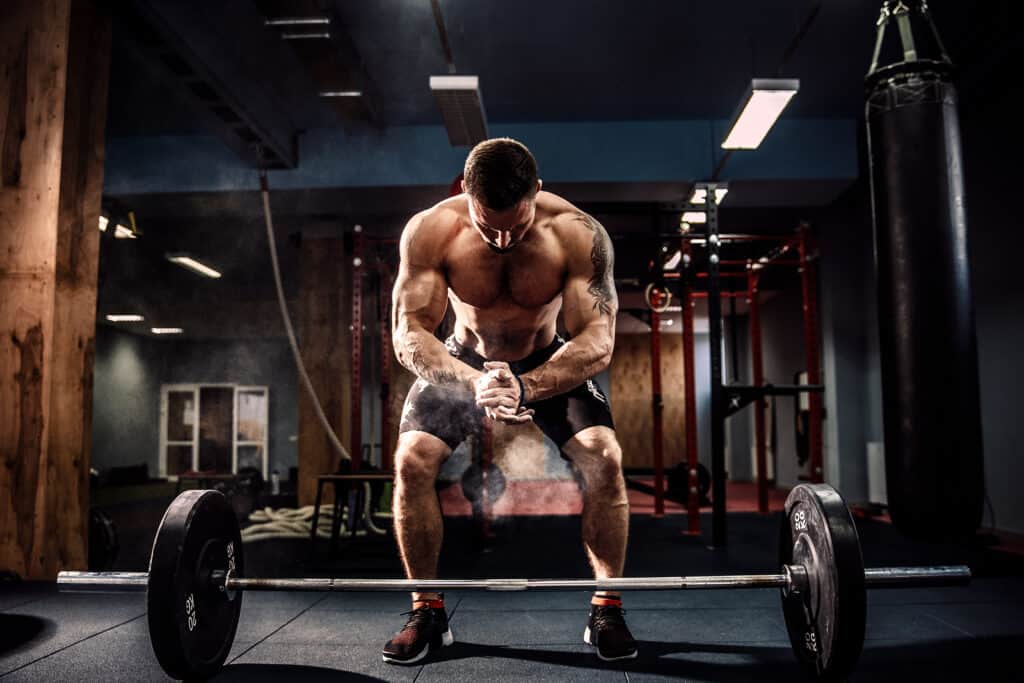One of the best and most often used exercises is the deadlift. It can be a challenging exercise, however, for many people. It is often performed incorrectly due to a multitude of reasons.
A good rule of thumb prior to lifting, is to address posterior chain mobility. This can be done by assessing back, hip and hamstring mobility. Try the following test, see if you can touch your fingertips to the bar prior to performing the deadlift. Attempt this by keeping the legs straight and not rounding your back. If you can, you’re in good shape.
Exercise Execution
Starting Position
- Begin with the feet flat, positioning them somewhere between hip and shoulder-width apart. Feet should be pointed straight or angled out slight (10-15 degrees), depending on your choice and experience. Note: some movement expert like Dr. Kelly Starrett suggest positioning feet straight ahead while others say turn the feet out slightly. Moreover, doing this engages more of the glute muscles like the glute medius. The question arises, however, can you brace your body and create the torque needed by “screwing” the feet into the floor when the feet are turned out?
- Next, squat down until the hips are lower than the shoulders grasping the bar with a closed, alternated grip (one overhand the other underhand). Other grip choices include double overhand and hook grips. Please note, if you have trouble getting into this position – you’re probably not ready to perform the movement due to hip or back mobility issues.
- Position the Olympic bar about 1-inch away from the front of your shins.
- Make sure you check off the following items regarding your body position. Your back is “flat”, relaxed neck & trapezius area, retract your shoulder blades, and position shoulders over the bar.
Upward Movement Phase
- Pull the bar from the floor by extending the knees and hips.
- This is key – do not let the hips rise before the shoulders.
- Keep the elbows extended and shoulders over the bar during the execution of the lift.
- As the bar passes the knees push the hips forward.
Downward Movement Phase
- To return the bar to the floor, think about sitting back first. Allow the hips and knees to flex as the bar returns to the floor.
- Maintain a flat back keeping elbows extending, looking straight ahead.

Exercise Options
Stiff-Leg Deadlift
Hex Bar Deadlift
Dumbbell Deadlift
Muscle Groups Involved During the “Compound Movement”
PRIME MOVERS (Hip Extensors)
- Gluteus maximus
- Hamstrings
STABILIZERS
- Quadriceps
- Lower leg
- Back
- Core
References
Essentials of Strength Training and Conditioning, 2nd Edition, NSCA, Baechle T. R., Earle R.W. Human Kinetics: Champaign, IL., 2000.
Becoming a Supple Leopard, Starrett K. and Cordoza G., Victory Belt Publishing: Las Vegas, NV., 2013.
Stay Strong Together
Jefit, named best strength app by Sports Illustrated, Esquire, GQ, Men’s Health, Greatest, Forbes Health, and many others, has a community responsible for 92,000,000 workouts to date! The app, which recently passed 10 million downloads, comes equipped with a customizable workout planner and training log. The app has ability to track data, offer audio coaching cues, and can share workouts with friends. Visit our members-only Facebook group. Connect with like-minded people, share tips, and advice to help get closer to reaching your fitness goals.
- Maximum Activation: Bear Crawl, Plank, & Dead Bug - April 2, 2025
- Boost Your Posterior Strength with 3 Effective Jefit Exercises - March 31, 2025
- 8 Underrated Stretches to Improve Your Deadlift Performance - March 28, 2025
